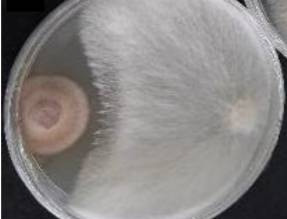A group from Laboratoire Biologie et Santé, UFR Biosciences, Université Félix Houphouët-Boigny d’Abidjan (UFHB), Côte d’Ivoire, etc. has reported about antagonist fungi isolated from soils of the rhizosphere of tomato crops against Sclerotium rolfsii.
https://www.ncbi.nlm.nih.gov/pmc/articles/PMC8857420/
S. rolfsii is the causative agent of white rot is one of the destructive pathogens of nightshade crops. In Côte d’Ivoire, this fungal pathogen constitutes a major constraint for the cultivation of tomato (Solanum lycopersicum) with 41.01% crop losses in humid forest areas.
Antifungal activity of soil fungi against S. rolfsii
The screening carried out from the 153 soil-based fungal isolates by means of a direct confrontation test on the PDA medium made it possible to select 10 fungi which inhibit the growth of S. rolfsii. The percentages of inhibition ranged from 27.06 to 60.59%. The mechanisms of action observed during this inhibition were competition and antibiosis. The former is caused by the rapid growth of the antagonist will slow down or inhibit the growth of the pathogen, and the latter is caused by inhibiting biological activity of the pathogen. Molecular identification (ITS) of these antagonist fungi revealed that the isolates belonged to the genera Talaromyces sp. (n = 4), Trichoderma sp. (n = 3), Penicillium sp. (n = 2) and Clonostachys sp. (n = 1).

Among 10 antagonost fung, Talaromyces purpureogenus and Talaromyces assiutensis exerted the antibiosis mechanism.
T. purpureogenus secreted Mitorubrin and mitorubinol, and
T. assiutensis secreted Spiculisporic acid as molecules responsible for inhibiting S. rolfsii.
